History made with CSAF presentation of service’s top valor medal
|
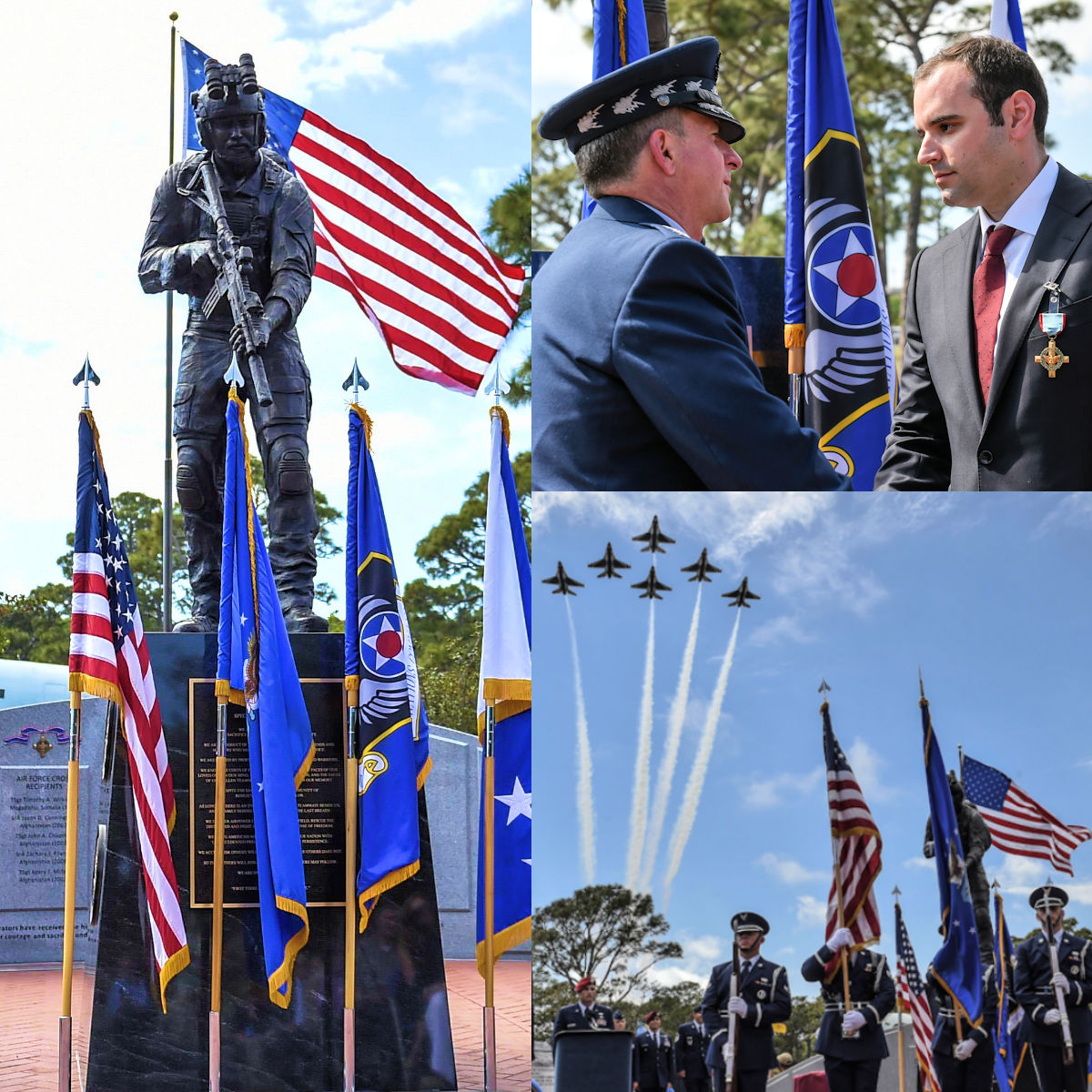
HURLBURT FIELD, Fla. --
A seven-foot bronze
statue stood prominently over a sea of multi-colored berets, flanked by
the 21st Chief of Staff of the Air Force and the Air Force’s
newest Air Force Cross recipients.
Two Airmen, whose
heroics were separated by 11 years and 100 miles in the same war zone,
solidified a Special Tactics legacy that has seen a great deal of
action since 9/11.
“You represent
the finest traits America can ask of its warriors, as you fight
alongside joint and coalition teammates in crises of the highest
consequence,” Gen. David L. Goldfein, 21st Chief of Staff of the
Air Force, said. “When lives are on the line, you move carefully
and deliberately into harm’s way with protection of others in
mind.”
For the first time in
history, two Air Force Crosses were simultaneously presented to Airmen
at the Special Tactics memorial as a result of a service-wide review of
medals, here, April 20.
Goldfein presided
over the historic event, presenting Christopher Baradat, a combat
controller since separated, and Master Sgt. (Ret.) Keary Miller, a
pararescueman, the service’s highest valor award.
The Air Force Cross
is presented for extraordinary heroism while engaged in military
operations against an enemy of the United States. These are the eighth
and ninth Air Force Crosses to be awarded since 9/11-- all have been
awarded to Special Tactics Airmen since the end of the Vietnam War.
“This is
the essence of Special Tactics,” Goldfein said. “You do
what others cannot, or will not do, and you do it because it must be
done, and because there is no one better.”
Both medal upgrades
were due to a DOD-directed review of medals from recent conflicts in
Iraq and Afghanistan to ensure service members are appropriately
recognized for their actions.
“We are a
highly trained and capable ground combat force leading global access,
precision strike, personnel recovery, battlefield surgery and command
and control missions; when tandemed with air and space power, we can
make the impossible, possible--- the decisive edge in battle,”
said Col. Michael Martin about the Special Tactics force, commander of
the 24th Special Operations Wing. “Keary Miller and Chris Baradat
are prime examples of our professional and battle hardened ground
combat force.”
During a 17-hour
battle on an Afghan mountaintop, then-Tech. Sgt. Miller, a Special
Tactics pararescueman --against overwhelming odds and a barrage of
heavy fire from Al Qaeda militants-- dashed through deep snow into the
line of fire multiple times to assess and care for critically-wounded
U.S. service members, March 4, 2002.
“The legacy of
Keary Miller is not one of momentary heroism, but of deliberate
professional assessment, the application of great skill, and the
willingness to risk his life to save another,” said Lt. Col.
Shane Mclane, commander of the 123rd Special Tactics Squadron, an Air
National Guard unit of Special Tactics Airmen in Louisville, Ky.
“Keary dashed into the line of fire repeatedly --not out of
disregard for the risks he face-- but because of his regard for his
fellow operator. Each time he did so, he made a deliberate
decision to risk his own life to save another. He lived by the
Pararescue Motto ‘That Others May Live.’”
At the time, Miller
was assigned to the 123rd STS. He was the combat search and rescue lead
to recover two fellow special operations members from the top of Takur
Ghar. During this mission, Miller is credited with saving the lives of
ten U.S. service members, and the recovery of seven who were killed in
action.
“We always had
a saying, ‘Train as you fight,’ and that’s what we
did,” said Miller. “We were used to training to the point
of failure so we wouldn’t fail for real. That’s the
community we work in; we learn to adapt to stressful and unrealistic
environments as a team.”
Eleven years later
and more than 100 miles north of Miller’s mission, then-Staff
Sgt. Baradat precisely directed thirteen 500-pound bombs and more than
1,100 rounds of ammunition during three hours of intense fighting
against the Taliban in a steep valley, contributing to the safety of
150 troops and destruction of 50 enemy and 13 separate enemy fighting
positions, in Afghanistan, April 6, 2013.
To many, Baradat
helped turn the tide of the battle, bringing close air support to deter
an overwhelming enemy force. Teammates and aircrew recalled him
stepping into the line of fire without regard for his own safety to
protect the ground force.
“I don’t
feel like I was doing anything above or beyond or heroic that day; I
was doing my job that I was supposed to do, with my team,” said
Baradat. “I had an amazing [U.S. Army] Special Forces team that I
was with that day … I was just a piece of the puzzle, and we
couldn’t have done it without everyone that day.”
At the time, Baradat
was on his third deployment to Afghanistan and was assigned to the 21st
Special Tactics Squadron, the most highly-decorated unit in modern Air
Force history.
For both medal recipients, the upgrade was both unexpected and humbling
– but the focus will always remain on their time serving their
country.
“I don’t
feel a responsibility as a medal recipient; it’s the oath we take
and the enlistment to serve our country,” said Miller. “In
the military, you take pride into what you are signing up
for…the Air Force has core values you believe in, and
that’s your day-to-day lifestyle.”
Fort Bragg airman to receive Silver Star for valor during battle to retake Kunduz, Afghanistan
An Air Force Combat Controller who risked his life during a battle to
retake the northern Afghanistan city of Kunduz in 2015 will receive the
Silver Star in a ceremony on Fort Bragg next week.
Tech. Sgt.
Brian C. Claughsey, part of the 21st Special Tactics Squadron, will be
honored with the medal, the third-highest award for valor offered by the
U.S. military, in a ceremony slated for Friday, 04/07/2017.
|
|
According to officials, he provided important support during
operations to liberate Kunduz from Taliban control, protecting U.S. and
Afghan forces while directing 17 close air support strikes from AC-130U
and F-16 aircraft.
The Silver Star will be the latest in a lengthy
history of valor from the 21st Special Tactics Squadron since the start
of the wars in Iraq and Afghanistan.
The unit, based at Fort
Bragg’s Pope Field, is the most decorated in modern Air Force history,
with four of the nine Air Force Crosses awarded since 2001 and 11
Silver Stars earned by the squadron’s airmen.
The medals have come
not because the unit seeks them, but because its members often serve
their country in the most dangerous of positions, officials said.
|
“Airmen
like Brian honor the Air Force’s incredible legacy of valor,” said Lt.
Col. Stewart Parker, commander of the 21st Special Tactics Squadron.
“Like those who’ve gone before him, he serves our nation with no
expectation of recognition.”
According to the squadron’s higher
command, the 24th Special Operations Wing at Hurlburt Field, Florida,
Claughsey recently completed Special Tactics Officer assessment and has
been selected to become an officer. He will soon attend Officer Training
School before commissioning as a second lieutenant.
Col. Michael E. Martin, commander of the 24th Special Operations Wing, praised the airman after officials confirmed the award.
“Brian is an exemplary airman and leader — he is a prime example of
the professionalism, courage, and tactical know-how of the Special
Tactics operator force,” he said. “In a violent, complex operating
environment, Brian decisively integrated air power with ground
operations to eliminate the enemy, and save lives.”
An official
description of Claughsey’s actions said he was part of a force that
deployed to Kunduz on Sept. 28, 2015, after the city had fallen to an
estimated 500 Taliban insurgents.
He volunteered to ride in the
lead convoy vehicle to assume close air support duties during the
movement into Kunduz and immediately took control of an AC-130U when the
troops were ambushed upon entering the city.
|
Claughsey directed
precision fires on an enemy strong point to protect the convoy. During a
second ambush, he coordinated friendly force locations with an overhead
AC-130U while directing “danger close” strikes.
When a
vehicle-borne improvised explosive device forced the convoy to stop in
the middle of a four-way intersection, Claughsey suppressed the machine
gun fire of six insurgents with his rifle while still coordinating with
the AC-130U. He directed the crew on the plane to destroy the enemy
fighters and helped shield the convoy from follow-on attacks as it made
its way to the compound of the Kunduz provincial chief of police.
There,
the American special operators and Afghan forces came under attack by
Taliban mortar fire. According to the narrative of the battle, Claughsey
maneuvered as close to the mortars’ origin as possible to pinpoint the
location to an overhead F-16. He then controlled numerous strafing runs
on the mortar position to eliminate the threat.
|
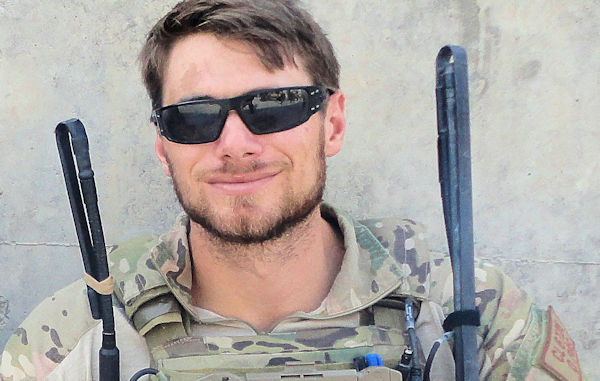 |
After helping to
destroy the enemy mortar position, Claughsey moved to suppress enemy
fire to allow another airman to direct another F-16 strike on the other
side of the compound. He then stood exposed to enemy fire to hold a
laser marker in position on an enemy building, directing two “danger
close” strikes on the building from the F-16.
Those strikes killed an unspecified number of enemy attackers, effectively ending the attack on the Kunduz police compound.
Claughsey,
from Connecticut, enlisted in May 2008 and became a Combat Controller
in February 2014, after two years of rigorous training, according to
officials. He has deployed twice, once to Afghanistan and once to Kuwait
as part of a global access special tactics team to survey and establish
airfield operations.
He has previously been awarded the Bronze
Star Medal, Air Force Commendation Medal with one oak leaf cluster and
Air Force Combat Action Medal.
| Four-day firefight: Combat controller earns Silver Star for Afghanistan valor |
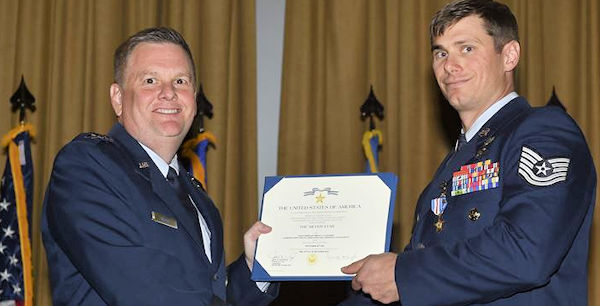 |
In September 2015, then-Staff Sgt. Brian Claughsey was deployed
with the 21st Special Tactics Squadron in Afghanistan when his team got
a call: The city of Kunduz was under attack by the Taliban.
Claughsey,
a combat controller, linked up with Army Special Forces soldiers with
the goal of liberating the city and recapturing its airfield.
In
an ongoing firefight over the next four days, he and the other members
of the team fought their way through back-to-back ambushes. Claughsey
engaged the enemy while calling in close-air support and helped keep
more than 100 people safe.
For his actions, Claughsey, now a
technical sergeant, received the Silver Star during a ceremony at Fort
Bragg, North Carolina, Friday. |
Liberating Kunduz
As Claughsey and his team were driving to the Kunduz airfield Sept. 29, 2015, they saw civilians fleeing the city.
“[That] is usually a pretty telltale sign that the Taliban has
taken over,” Claughsey told reporters during a phone interview
Friday before the ceremony.
After a night of fighting, the U.S. service members re-secured the
airfield, but when they returned to the forward operating base, they
were told the entire city had fallen to the Taliban.
“We were going to go back in that night and go all the way into
the city and liberate Kunduz so we could give [the residents] their
city back,” he said.
Claughsey
rode in the fourth truck of a 50-vehicle convoy, consisting of pickup
trucks from the Afghan National Army and vehicles from the Special
Forces team.
“As we started going into the city, we got past the airfield and
as soon as we [did], we started taking fire from a building,” he
said.
Claughsey called in the AC-130U flying overhead and directed fire
toward the Taliban position, according to his Silver Star narrative.
“We got back into the convoy, and from there on out, [we took
fire] about every 100 to 200 meters,” he said. “The C-130
did a phenomenal job of putting rounds down and keeping us safe and
allowing us to continue on.”
After
a third ambush from a vehicle-borne improvised explosive device that
was detonated, the convoy had to stop at a four-way intersection where
six insurgents opened fire with machine guns.
As Claughsey’s truck attempted to suppress the enemy, two Special
Forces soldiers drove an all-terrain vehicle between the truck and the
enemy, engaging them with a machine gun.
“Those two guys were really the reason my vehicle survived any of
that ambush,” he said, adding that he also directed C-130 fire on
the insurgents.
With them out of the way, the team cleared one of the buildings off the
road — from which they operated for the next four days.
“Once we got into that compound, it was fairly sustained fighting
for four days,” he said. “There was no downtime …
you typically see lulls in the fight, like at night. That certainly
didn’t happen.”
At one point, one of the special operators called Claughsey on the radio to ask for support at their position.
“They were taking very effective fire from mortars and small
arms,” he said. “I coordinated with the [overhead] F-16 and
did some strafing.”
The repeated attack from the low-flying F-16 was effective, but a few
hours later, the Taliban made a final push to try to take over the
compound.
The troops were attacked from three sides, which pinned Claughsey down
on a rooftop while another combat controller called in air support on
another side of the compound.
While stuck on the roof, Claughsey and a Special Forces soldier engaged the enemy with M4 assault rifles and grenade launchers.
The fighting lasted about an hour, with Claughsey using his weapon’s laser to mark the enemy location for F-16 strikes.
After the close-range strikes, the fighting ended and Claughsey was able to get off the roof.
“Over
the course of the intense firefight to liberate Kunduz from Taliban
control, Staff Sergeant Claughsey expertly coordinated 17 separate
close-air support engagements, resulting in many enemy killed in action
and no civilian or friendly casualties — ensuring the safety of
36 U.S. Army Special Forces personnel and the 110 Afghan partner force
personnel,” according to the narrative.
Humble hero
Claughsey, who enlisted in 2008, said his intense, two-year training helped prepare him for a situation like this.
“Your training kicks in and it takes over,” he said.
“It wasn’t the first time I was stressed out or
hadn’t slept in four days straight.”
The combat controller community also shares stories with each
other to make sure younger guys are ready to get out there and adapt to
whatever they might be exposed to, Claughsey said.
Lt. Col. Stewart Parker, the 21st Special Tactics Squadron commander, said he has enjoyed his time working with Claughsey.
“You’d never know if you met him on the street the kind of hero he
is because he just doesn’t wear it on his sleeve,” Parker said.
Claughsey
said receiving the Silver Star is “really humbling” and shows him that
the other combat controllers and Special Forces team members had
confidence in him.
“It’s humbling to be a part of such a large
team and such a joint force that did a really incredible job of getting
the city back to the Afghan people, who deserved to have their city,”
he said.
Watching the state of the city change from when they
arrived to when the civilians were able to return was a great feeling,
he said.
|
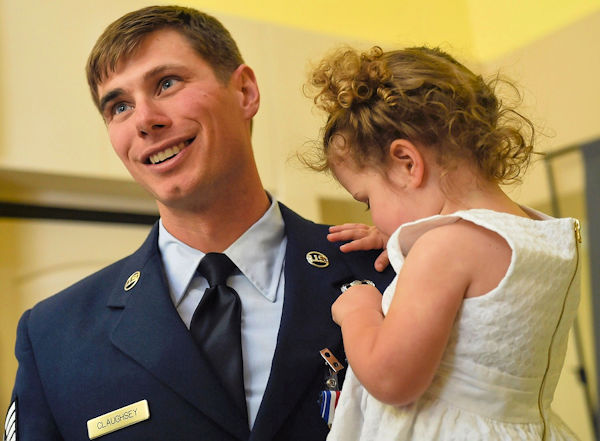 |
“When
we came in, it was nothing but Taliban,” Claughsey said.
“And these people were back in their homes and waving on our way
out.”
Airman receives Silver Star for heroics in Afghan battle
|
 |
A force of 130 American and Afghan troops were under siege,
surrounded in a government compound deep in the heart of a city
controlled by more than 2,000 Taliban fighters.
At times pinned
down on the roof of the compound and constantly facing threats from
enemy machine guns, rocket-propelled grenades and mortars, Air Force
Tech. Sgt. Brian C. Claughsey calmly directed the air support that kept
the U.S. and Afghan troops alive and helped loosen the Taliban’s grasp
on the city, a provincial capital in the country’s north.
During
the four-day battle in September and October 2015, Claughsey’s support
was critical, the leader of an Army Special Forces team wrote when
recommending the airman for one of the nation’s highest awards for
valor in combat.
|
Without
him, the commander wrote, the U.S. and Afghan forces would have likely
taken casualties and would not have been successful in their mission to
establish a foothold in the besieged city.
With no break in the fighting, Claughsey controlled more than 17 close
air support missions, often while exposing himself to enemy fire to
better pinpoint targets for overhead AC-130U gunships and an F-16,
officials said. He repeatedly put his well-being at risk to ensure the
safety of those he fought alongside.
For those efforts, Claughsey, part of the 21st Special Tactics
Squadron, received the Silver Star in a ceremony at Fort Bragg’s
Pope Theater on Friday.
Lt. Gen. Brad Webb, commanding general of Air Force Special Operations
Command, pinned the medal – the U.S. military’s third
highest award for valor – on the airman’s chest.
The general said Claughsey’s efforts killed at least 47 enemy
fighters with no civilian casualties. He also helped ensure that no
allied forces were wounded during the lengthy fight.
“I hope I’m doing justice painting the picture of
Brian’s contribution,” Webb said while explaining how
Claughsey and the other troops fought their way into the city two days
after the Taliban launched an all-out assault that drove Afghan
soldiers and police out of the area.
Webb said the attack on Kunduz came as a surprise to intelligence
analysts, who predicted that the Taliban would be focused on the
southern part of Afghanistan, near their traditional strongholds.
The U.S. military was less than a year into the Resolute Support
Mission, he said, meaning the focus of operations was more on advising
and assisting Afghan forces and less about the U.S. military being in
the lead.
The fall of Kunduz, Webb said, was a huge concern.
“The Taliban overran the city. It was their first major victory in 14 years,” he said.
“If Kunduz falls, what’s to stop Kandahar and some of the
major cities, even Kabul, from coming under attack?” Webb added.
With civilians fleeing the Taliban-controlled city, Claughsey’s
Special Tactics team – based at Bagram Airfield – was
called to action. Embedding within a group of soldiers from the Fort
Bragg-based 3rd Special Forces Group, the U.S. force and its Afghan
counterparts first pushed their way to Kunduz a day after the Taliban
began its assault and a day before the events described in
Claughsey’s Silver Star citation.
That night, Sept. 29, 2015, Claughsey was part of the team that
recaptured an airfield just outside Kunduz that would be key to the
eventual liberation of the city.
The next day, as the Taliban tightened its control of Kunduz, Claughsey
and his team were charged with returning to the city, which they were
told had completely fallen.
“Their charge was to dig deep in to the city, clear some key
government buildings, establish control and set conditions for taking
back the city of Kunduz,” Webb said.
That was no easy task, according to officials.
Claughsey said the allied force arrived at the city’s outskirts
in a 50-vehicle convoy, with many of the vehicles borrowed from the
Afghan army.
The airman was in one of the first vehicles, a lightly armored Ford Ranger pickup.
Claughsey sat in the bed of the truck, keeping a watchful eye as the troops entered the city.
Within Kunduz, the Taliban was preparing to fend off the invading
force. They freed more than 700 prisoners, many of whom stayed to fight
the joint American-Afghan force.
The expected ambush came as the force passed the airfield, Claughsey
said. With Taliban fighters opening fire from a nearby building.
He directed an overhead AC-130U “Spooky” gunship to attack
the enemy location, which stopped the attack, providing a brief respite
before what would become 96 hours of sustained combat.
As the troops moved into the city, they came under attack every 100 to 200 meters, Claughsey said.
At one point, the convoy was ambushed in an attack that started with a
vehicle-borne improvised explosive device that briefly trapped
Claughsey’s vehicle in the center of a four-way intersection
while two groups of Taliban fighters opened fire with machine guns.
Two more heavily armored Special Forces vehicles drove to the rescue of
Claughsey and the others in his truck, blocking them from the guns and
allowing them to get out of the kill zone.
During the attacks, Claughsey turned his weapon on the enemy while
continuing to control air support, sending aircraft on strafing runs to
target enemy fighters looking to out maneuver the convoy.
The city was devoid of civilian life, he said. And their entire route was covered by Taliban fighters.
Over the four days of fighting, Claughsey took turns controlling the
steady presence of overhead aircraft with another combat controller and
an Army Special Forces soldier.
“There really was no downtime,” he said.
A force of 130 American and Afghan troops were under siege,
surrounded in a government compound deep in the heart of a city
controlled by more than 2,000 Taliban fighters.
At times pinned
down on the roof of the compound and constantly facing threats from
enemy machine guns, rocket-propelled grenades and mortars, Air Force
Tech. Sgt. Brian C. Claughsey calmly directed the air support that kept
the U.S. and Afghan troops alive and helped loosen the Taliban’s grasp
on the city, a provincial capital in the country’s north.
During
the four-day battle in September and October 2015, Claughsey’s support
was critical, the leader of an Army Special Forces team wrote when
recommending the airman for one of the nation’s highest awards for
valor in combat.
Claughsey said that after the fighting
ended, the once desolate city returned to life. As the troops were
relieved, he said they could hear people returning to their homes and
children playing.
“We didn’t see or hear a single civilian until we were
about to exfil,” Claughsey said. “It was a pretty
incredible feeling… It meant we were successful.”
The fighting was the heaviest of Claughsey’s Air Force career, which included one other deployment.
But while the airman was exhausted, he never thought he was in over his head.
“The training kicks in and it takes over,” Claughsey said,
describing the grueling two-year pipeline to become a Special Tactics
airman and combat controller. “It wasn’t the first time I
hadn’t slept or had been stressed for four days straight.”
“It was the first firefight of that magnitude that I had seen, but I felt like I had been there before,” he added.
Lt. Col. Stewart Parker, commander of the Fort Bragg-based 21st Special
Tactics Squadron, said Claughsey’s actions during the Battle of
Kunduz were another chapter in the legacy of the unit, the most
decorated in modern Air Force history.
The squadron’s airmen have earned four Air Force Crosses and 11 Silver Stars since 2001, according to officials.
But Parker said none of the unit’s airmen have sought out those honors.
“The bottom line is the teams here are not seeking any of this
recognition,” the squadron commander said. “It’s
really about the job for them.”
Special Tactics is a force of highly trained airmen, Parker said, who provide an important set of specialized skills.
And the valor the unit has been honored for over the years is a natural part of the job.
“These guys are incredibly humble,” Stewart said.
“They’re all about the mission… This is just the
recognition that comes with doing a great job.”
Stewart said Claughsey was an incredibly professional, competent and
humble airman. But he’s “absolutely a hero,” too,
despite an easygoing, mild-mannered demeanor.
“You would never know if you met him on the street the kind of
hero he is because he doesn’t wear it on his sleeve,”
Stewart said.
Claughsey said he was humbled to receive the medal. He repeatedly
praised the efforts of the Special Forces team and Afghans he fought
alongside, as well as the crews flying overhead.
“They did a phenomenal job,” he said.
The Silver Star was extra special, Claughsey said, because he was recommended for it by his Army counterparts.
“This
was absolutely a joint fight,” he said. “It couldn’t
have been done without them. They were absolutely incredible.”
With the medal in hand, Claughsey is now ready to embark on a new chapter in his career, officials said.
According
to the squadron’s higher command, the 24th Special Operations Wing at
Hurlburt Field, Florida, Claughsey recently completed Special Tactics
Officer assessment and has been selected to become an officer. He will
soon attend Officer Training School before commissioning as a second
lieutenant.
|
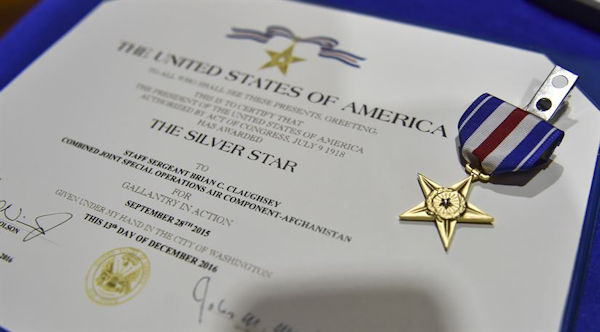 |
Becoming
an officer will allow Claughsey to “widen his umbrella” and
take care of a larger group of airmen, he said. “I’m
absolutely looking forward to it.”

|